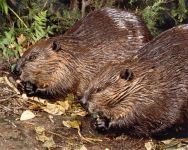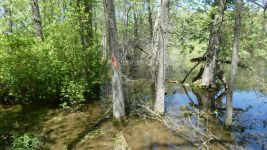


|

|
|
 
|

After what seemed like many months of torrential rain and flooding (see photo), we have now had some relatively dry weather. This has enabled us to clear more of the trails making it easier for visitors to explore and appreciate this fascinating environment. The plant life is flourishing with an abundance of beautiful flowers, attracting numerous insects to help in the cycle of life. Our main pond continues to be a vital home or resting place for waterfowl (Michael, our manager, counted 130 Canada geese in the pond at one time). Beavers are making their presence known; enjoy our recent footage of an entire family swimming and playing one late afternoon. Although we think the Refuge is a jewel all year round, it is truly a magical place in the spring and summer. We hope you will find time to visit and enjoy the wonders of nature that abound.
We -- and the wildlife -- are grateful for your continued support.